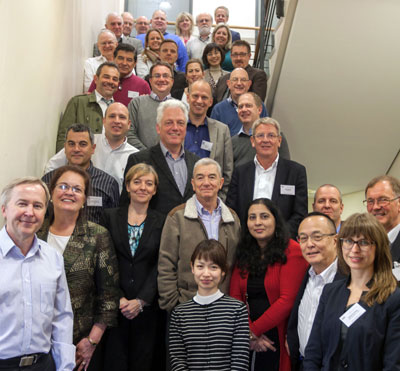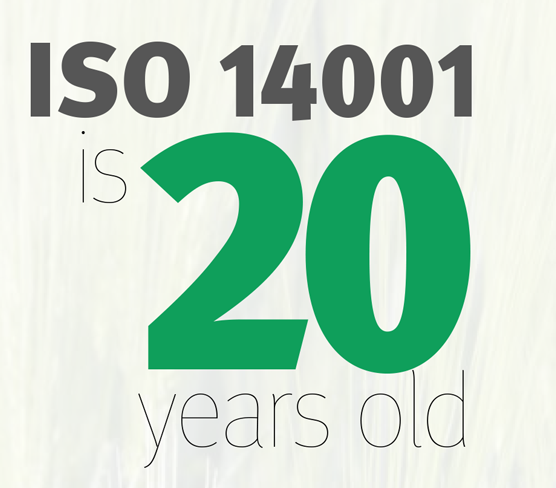
ISO 14001:2015 is hot off the press – the world’s favourite International Standard for environmental management has been brought firmly into the 21st century. This is an important step forward for a critical environmental standard, one that covers all environmental challenges – water, air, soil, waste, biodiversity, ecosystem services, climate challenges, etc. – in one standard and helps organizations to manage them in a holistic manner.
For a world continuing to face environmental challenges, this is excellent news. Doing one’s bit to protect the world has gone from buzz word to strategic business imperative in recent years. And as society and the planet grapple with issues such as natural disasters, deforestation, overpopulation, climate mitigation and adaptation, etc., companies are continuing to recognize the need to manage their environmental challenges and contribute towards finding solutions to the issues facing us all.
“The standard looks very different,” says Susan Briggs, Convenor of the working group responsible for the revision of ISO 14001, who has extensive experience implementing environmental management systems, “but primarily, from a technical point of view, the real changes come from the increased focus on sustainable development. We want to not only prevent pollution, but we want to protect the environment from harm and degradation, so we have incorporated that thinking into the standard.”
For any organization using or thinking of using ISO 14001 as well as the approximately 300 000 organizations worldwide that are certified to the standard, the revision poses questions like: What are the changes involved? And what must be taken into consideration in the future?
Moving forward
ISO 14001 was first published in 1996, though the need for an international environmental standard dates back to the 1992 Earth Summit in Rio, which put sustainable development squarely on the political agenda.

“In its almost 20 years’ existence, ISO 14001 has been hailed as the world’s most successful environmental standard, its acclaim being attributed both to its accessibility (it applies in equal measure to heavy industry, service and public sectors, and SMEs) and to its ability to help companies deliver business and environmental improvements, cut costs and improve compliance management,” comments Anne-Marie Warris, Chair of the subcommittee with responsibility for ISO 14001.
The current version of the standard dates back to 2004. Life has moved on since then. “[…] the whole awareness of environmental issues, including water availability/use and climate challenges, has come a long way,” says Anne-Marie, and it was time to “look at how ISO 14001 can continue to be relevant for modern organizations as they deal with the environmental challenges we all face.”
Moreover, ISO 14001 has not been immune to criticism over the years. Yet many believed there was still plenty of opportunity for increasing the standard’s uptake, though a more strategic approach was needed.
What motivated the standard’s revision? Initially, work was carried out to identify the future challenges of environmental management, the outcome of which was a number of themes such as “being part of sustainability and social responsibility”, “the link to strategic business management”, “considering environmental impacts in the value/supply chain”, etc. Secondly, it was decided that the revision should use ISO’s new common framework for management systems; and thirdly, the revision was informed by the outcome of the survey carried out in 2012/2013.
The survey focused on two main areas, namely the extent to which ISO 14001 should address or strengthen attention to future challenges for environmental management and the perceived value of the ISO 14001 standard for both business management and environmental management. This gave the impetus to what needed to be changed, explains Maiko Okuno of Mitsubishi UFJ Research and Consulting, one of the experts involved in analysing the survey responses, who took part in the revision of ISO 14001.
Hence the new edition takes into account the latest changes in environmental management practices, and reflects the increasingly complex, demanding and dynamic environment in which modern-day organizations operate.
Benefits from using ISO 14001

Achieving accredited certification to ISO 14001 certainly delivers commercial value to an organization, including reduced greenhouse gas emissions and streamlined waste management, as well as providing a better handle on business risk and competitive advantage. So it’s commercially good for business as well as helping the environment.
Antonio Burgueño, Quality and CSR Director of FCC Construction, a Spanish construction company based in Barcelona, is full of praise: “ISO 14001 has brought us a number of benefits, namely consistency and structure in our processes with third parties and across our organization globally.”
“It has also helped us to improve our environmental impact significantly. In 2014 alone, we cut our carbon emissions by more than 23 tonnes, our dust production by more than 20 tonnes and we reused 116 m of water,” he said. “That is in addition to the more than 6 million m of surplus clean rubble that we reused or recycled instead of sending to landfill.”
In fact, companies report as the dual motivation for implementing the standard the desire to enhance their public image coupled with a general commitment to protecting the environment. “Without a certified management system, we would not be able to win business from many of our customers,” concludes Bob Cutler, General Manager, Oil Testing, at ALcontrol, one of the world’s leading environment and food testing companies that provides analytical services to organizations around the world.
Reaching out
The new version of ISO 14001 aims to reach out to SMEs. Amarjit Kaur, a Malaysian national expert from SHEMSI Sdn Bhd, participating in the revision, explains, “Small and medium-sized companies are a bit intimidated by the term ‘sustainability’, but by getting them to think about the concepts of protecting the environment and life-cycle perspective, they will already be on the path to sustainability without even realizing it.”
With a stronger focus on performance and outcomes, the new edition should help companies, including SMEs, achieve measurable environmental improvement.
Better strategic fit

There are a number of key changes in the standard. Bringing environmental management to the Boardroom and bringing the Boardroom strategic focus to environmental management is one most noticeable for CEOs and other senior directors. They now have real reason for getting involved in this important area for their business as it links with their activities and concerns. Amarjit Kaur considers bringing environmental performance into the strategic day-to-day business of the organization as possibly the most important change. “I commend that,” she says passionately, “I hope that with this new approach – by making it more explicit – the environment will be one of those core agendas in meetings discussing strategy and directions of the organization.”
With the focus firmly on the Boardroom a new clause has been added assigning specific responsibilities for those in leadership roles, which also puts them more in control of their organizational strategies. Management is about processes, but leadership is about behaviour. Good leaders establish unity of purpose and direction within the organization, sustaining an internal corporate culture in which people can become fully involved in achieving the organization’s objectives. This involvement of leaders will help optimize the performance of the organization’s environmental management system, making it more sustainable, cutting costs and helping to preserve the world’s resources for future generations.
Environment – your impact and its effect on you

Continuing on the theme of business focus, companies are required to look at their unique context and identify the effect the environment is having on their business. It involves taking new factors into account that are specific to the organization’s context, such as climate volatility, adaptation to change in the environment and resource availability. This is a big leap forward as the effect of the environment on the organization was previously not included in the scope of the standard.
Clearly, protecting the environment remains a key ethos of ISO 14001 as does the duty of the organization to commit to proactive initiatives to safeguard the environment from harm and degradation. This can include issues such as the sustainable use of resources, preserving the local biodiversity and ecosystems, and taking measures to prevent pollution.
The concept of “context” also means companies have to consider other issues not obviously related to narrow environmental concerns, but which can have detrimental effects on its business, like the competitive landscape in which they operate, technology and even cultural factors. Focusing both inward and outward can help organizations to leverage opportunities that could benefit both the organization and the environment.
Life-cycle perspective
The concept of life-cycle perspective emerges in this version of the standard, which requires organizations to take a broader view and deal with their environmental issues in a more holistic way. The idea, says Susan Briggs, involves “looking at the performance, not just of the operations of the organization, but of the products they create and their use and final disposal”. Life-cycle perspective does not require a detailed life-cycle assessment but it means organizations needs to think about the life-cycle stages that can be controlled or influenced by the organization, this can include raw-material acquisition, design, production, transportation/delivery, use, end-of-life treatment and final disposal. What the life-cycle stages are will vary from product to product and from service to service.
Common framework
ISO 14001 will become the tool of choice for organizations to integrate environmental issues.
The latest revision of the standard follows ISO’s common framework for management system standards which provides an overarching skeleton for management systems, including the core text, common terms and core definitions.
This new framework is known as Annex SL by experts, as a reference to the ISO/IEC Directives where it can be found, or as the “High-Level Structure”. It is designed to benefit users and enhance consistency between the different management standards, making it much easier to implement multiple management systems as well as link with common business systems.
So is it more prescriptive or not?
The above implies the standard is more prescriptive as compared to the 2004 edition. But is it? “For all its new ‘requirements’,” comments Amarjit Kaur, “ISO 14001 provides more flexibility for organizations in the way they address the requirements than in earlier versions and places more emphasis on improving environmental performance. It provides a framework for a holistic, strategic approach to the organization’s environmental policy, plans and actions – allowing companies to set it within the specific context of their organization.”
Rite of passage

Anne-Marie Warris is confident the new edition will be a key asset to organizations, predicting that “ISO 14001 will become the tool of choice for organizations to integrate environmental issues, and dependencies such as water use, into business strategic thinking, actions and plans.”
Following the release of ISO 14001:2015, those organizations certified to the 2004 edition have three years to demonstrate they meet the requirement in the 2015 edition. As Anne-Marie concludes with a note of optimism: “Change looks really scary, but it’s just a question of starting in one corner and getting on with it.”

